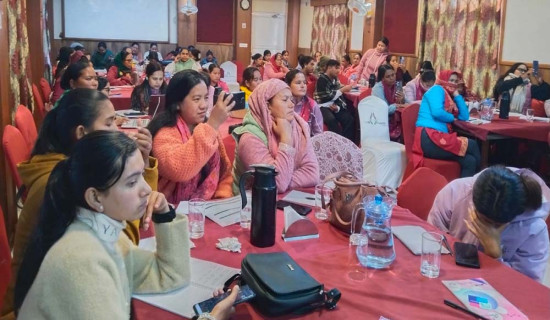- Wednesday, 24 December 2025
Manage Pashupati Pilgrims Properly
Bini Dahal
On my way back home, I came across a very weird scene, the other day. Right outside the premises of Pashupatinath Temple, a lot of washed clothes were being hung on railings installed along the footpath. Not just this, the cloth owners seemed to have tried their best to hang some of the garments on branches of trees. Apparently, the clothes belong to pilgrims who visit the temple for worshipping.
This is a common tendency among budget travellers. Most often these travellers travel by bus, carrying all the required utensils and cooking gas and stay near the temple. They sleep inside their buses and perform most of activities outdoor. So, they adapt themselves to perform everything without any fixed accommodation.
With Kathmandu’s high pollution level and heavy traffic, I do not quite understand how they can dry their clothes out in the open. But the major issue is the untidy and unpleasant environment such travellers cause. If we look at the area, we cannot help calling it a squatter. However, mismanaged makeshift huts of the pilgrims around this famous Hindu temple premises are a big embarrassment. The concerned authorities do not seem to be stepping up any concrete measure to deal with this perennial problem.
Pashupatinath Temple, a UNESCO World Heritage Site, is regarded as one of the most sacred places in the Kathmandu Valley. The religious value of this temple is so high that hundreds of thousands of Hindus from around the world visit it every year. Nearly every Hindu aspires to visit the temple at least once in their lifetime. Not just these pilgrims but even other international tourists are curious about the architecture of this temple, which is one of the oldest shrines in Nepal.
While this is a great experience for all the travellers, including the pilgrims, Nepal’s tourism sector, however, cannot just benefit from them. Tourism is an important part of our national economy. And we have seen how coronavirus has caused the influx of tourists to fall. However, the situation is changing as the number of cases of this viral disease has fallen down considerably. As a result, more and more tourists have not started visiting the country.
There is no need to explain the rich natural and cultural heritage that Nepal is the owner of. So, to increase the amount of benefit we can receive from the tourism sector, we need to develop certain circuits. Tourism is not about visiting a particular place. It is also about spending a certain amount of money on the places visited.
Cultural and religious heritages need to be maintained in a better way. Rather than allowing the pilgrims to live outside temples, the government can come up with provisions of managing affordable accommodations. The pilgrims should also not be allowed to everything on roads and streets.
Even if hundreds and thousands of tourists visit the country, the inability to earn the required amount of foreign currency is our failure. Nepal’s tourism requires foreign tourists for the economy to grow. Their spending is crucial to increase the foreign currency reserve of the country and also to create direct and indirect employment opportunities. Tourism should be a way of creating wonderful experiences for visitors while ensuring environmental sustainability. It should not be a way for giving people a free pass to do whatever they wish to do.

















